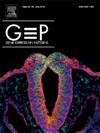hnRNPL expression dynamics in the embryo and placenta
Abstract
Heterogeneous nuclear ribonucleoprotein L (hnRNPL) is a conserved RNA binding protein (RBP) that plays an important role in the alternative splicing of gene transcripts, and thus in the generation of specific protein isoforms. Global deficiency in hnRNPL in mice results in preimplantation embryonic lethality at embryonic day (E) 3.5. To begin to understand the contribution of hnRNPL-regulated pathways in the normal development of the embryo and placenta, we determined hnRNPL expression profile and subcellular localization throughout development. Proteome and Western blot analyses were employed to determine hnRNPL abundance between E3.5 and E17.5. Histological analyses supported that the embryo and implantation site display distinct hnRNPL localization patterns. In the fully developed mouse placenta, nuclear hnRNPL was observed broadly in trophoblasts, whereas within the implantation site a discrete subset of cells showed hnRNPL outside the nucleus. In the first-trimester human placenta, hnRNPL was detected in the undifferentiated cytotrophoblasts, suggesting a role for this factor in trophoblast progenitors. Parallel in vitro studies utilizing Htr8 and Jeg3 cell lines confirmed expression of hnRNPL in cellular models of human trophoblasts. These studies [support] coordinated regulation of hnRNPL during the normal developmental program in the mammalian embryo and placenta.

 求助内容:
求助内容: 应助结果提醒方式:
应助结果提醒方式:


